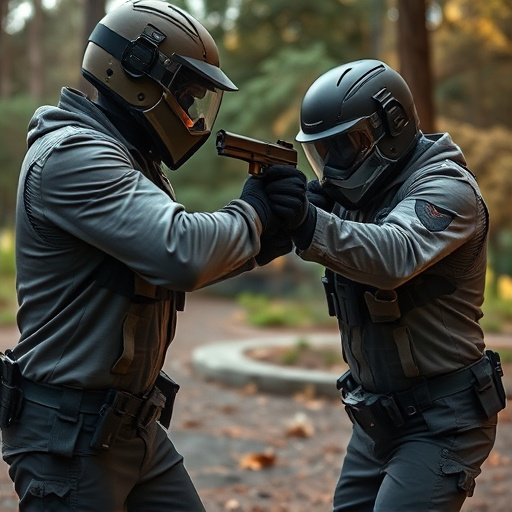Self-defense stun guns are gaining popularity among college students as a safe way to protect themselves on campus. When choosing a stun gun, consider voltage output, weight, range, and additional features like flashlights. Key features of college student-focused stun guns include high voltage (50,000-150,000 volts), lightweight design, simple activation, LED lights, durable construction, and water resistance. Local laws and campus regulations regarding self-defense devices vary widely; students must research these to ensure legal compliance, as non-compliance can result in fines or criminal charges. Testing and user reviews are crucial for making an informed decision based on both professional assessments and real-life experiences.
“Self-defense is a vital consideration for college students, and non-lethal self-protection devices offer a viable option. This comprehensive guide delves into the world of self-defense stun guns, equipping you with essential knowledge. We explore key features crucial for student safety, legal aspects, and the importance of testing to ensure effectiveness. Discover the specifications that make these devices reliable allies in navigating potentially dangerous situations. Stay prepared, stay safe—arm yourself with the facts on self-defense stun guns tailored for your academic journey.”
- Understanding Self-Defense Stun Guns: A Comprehensive Overview
- Key Features and Specifications for College Student Safety
- Legal Considerations and Permits for Carrying Stun Devices
- Testing and Reviews: Ensuring Effectiveness and Reliability
Understanding Self-Defense Stun Guns: A Comprehensive Overview
Self-defense stun guns have emerged as a popular choice, especially among college students looking to protect themselves while on campus. These compact and non-lethal devices are designed to incapacitate an assailant temporarily, giving users time to escape or summon help. Unlike traditional firearms, stun guns use electric current to disrupt muscle control, ensuring a safe but effective response.
For students considering self-defense options, understanding the specs of these devices is crucial. Key features include voltage output (typically 50,000-120,000 volts), weight (often lightweight for ease of carrying), and range (the distance at which the stun can be effective). Some models also offer additional features like a built-in flashlight or a belt clip for easy accessibility. When choosing a stun gun, it’s important to consider local laws regarding self-defense devices, ensuring you select one that complies with campus regulations.
Key Features and Specifications for College Student Safety
When it comes to self-defense tools tailored for college students, self-defense stun guns stand out as a popular and effective choice. These compact devices pack a significant punch, offering a non-lethal but powerful option for personal safety on campus. Key features to look for include a high voltage output, typically ranging from 50,000 to 150,000 volts, ensuring it can incapacitate an attacker without causing severe harm. The stun gun should be lightweight and ergonomically designed, fitting comfortably in the hand for easy carry and rapid deployment.
Specifications also include a simple and intuitive activation mechanism, often a single trigger or button, allowing users to respond quickly under stress. Some models incorporate LED lights for visibility during low-light situations, while others feature advanced functions like stun pulse technology for enhanced effectiveness. Durability is essential; the device should be constructed from robust materials capable of withstanding regular use and potential impact. Water resistance and a sleek, concealable design further enhance its appeal for students concerned about personal safety while attending classes or walking alone at night.
Legal Considerations and Permits for Carrying Stun Devices
In many regions, self-defense stun devices, often referred to as stun guns or personal stun weapons, are legal and available for purchase by individuals seeking effective yet non-lethal means of protection. However, navigating the legal considerations surrounding their possession and carrying is crucial, especially for college students considering self-defense options. The regulations vary significantly from one jurisdiction to another, with some areas allowing stun devices without a permit while others mandate specific licenses or permits for their carriage.
For instance, in the United States, certain states have ‘stand your ground’ laws that protect individuals from legal repercussions when using reasonable force, including stun devices, to defend themselves against perceived threats. College students considering self-defense stun guns should thoroughly research local and state laws to understand the permitted types, power outputs, and any restrictions on carrying them on campus or in public. Permits or licenses may be required, and failure to comply can result in fines, confiscation of the device, or even criminal charges.
Testing and Reviews: Ensuring Effectiveness and Reliability
Testing and reviews play a pivotal role in ensuring the effectiveness and reliability of self-defense stun guns, especially when targeted at college students seeking non-lethal protection. Independent testing agencies conduct rigorous assessments to verify the device’s performance, including its ability to deliver the claimed electrical shock and stun effect. These tests often involve simulating various scenarios to gauge the stun gun’s consistency and reliability in different conditions.
Online reviews from users who have actually employed these devices in real-life situations offer valuable insights. College students should seek out reviews that specifically focus on self-defense stun guns, paying attention to factors like ease of use, comfort during carrying, and the perceived sense of security it provides. Reviews can help identify potential issues or strengths not immediately apparent from product specifications, ensuring that students make informed decisions about their personal safety while on campus.
Self-defense stun guns have emerged as a popular choice for college students seeking to protect themselves while on campus. With key features like high voltage, compact design, and quick activation mechanisms, these devices offer an effective non-lethal option for personal safety. Understanding the legal considerations and ensuring proper testing are vital steps in choosing the right stun gun. By considering these factors, college students can make informed decisions to enhance their security while navigating campus life.
